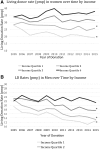The Change in Living Kidney Donation in Women and Men in the United States (2005-2015): A Population-Based Analysis
- PMID: 29519800
- PMCID: PMC5875963
- DOI: 10.1681/ASN.2017111160
The Change in Living Kidney Donation in Women and Men in the United States (2005-2015): A Population-Based Analysis
Abstract
The factors underlying the decline in living kidney donation in the United States since 2005 must be understood to inform strategies to ensure access to this option for future patients. Population-based estimates provide a better assessment of donation activity than do trends in the number of living donor transplants. Using data from the Scientific Registry of Transplant Recipients and the United States Census, we determined longitudinal changes in living kidney donation between 2005 and 2015, focusing on the effect of sex and income. We used multilevel Poisson models to adjust for differences in age, race, the incidence of ESRD, and geographic factors (including population density, urbanization, and daily commuting). During the study period, the unadjusted rate of donation was 30.1 and 19.3 per million population in women and men, respectively, and the adjusted incidence of donation was 44% higher in women (incidence rate ratio [IRR], 1.44; 95% confidence interval [95% CI], 1.39 to 1.49). The incidence of donation was stable in women (IRR, 0.95; 95% CI, 0.84 to 1.07) but declined in men (IRR, 0.75; 95% CI, 0.68 to 0.83). Income was associated with longitudinal changes in donation in both sexes, yet donation was stable in the highest two population income quartiles in women but only in the highest income quartile in men. In both sexes, living related donations declined, irrespective of income. In conclusion, living donation declined in men but remained stable in women between 2005 and 2015, and income appeared to have a greater effect on living donation in men.
Keywords: gender difference; income; kidney transplantation; living kidney donation; sex.
Copyright © 2018 by the American Society of Nephrology.
Figures




Comment in
-
Gender Disparities and Financial Barriers to Living Kidney Donation.J Am Soc Nephrol. 2018 Apr;29(4):1081-1083. doi: 10.1681/ASN.2018020158. Epub 2018 Mar 8. J Am Soc Nephrol. 2018. PMID: 29519801 Free PMC article. No abstract available.
References
-
- Tonelli M, Wiebe N, Knoll G, Bello A, Browne S, Jadhav D, et al. .: Systematic review: Kidney transplantation compared with dialysis in clinically relevant outcomes. Am J Transplant 11: 2093–2109, 2011 - PubMed
-
- Available at: http://www.unos.org. Accessed October 22, 2017
-
- Kayler LK, Meier-Kriesche HU, Punch JD, Campbell DA Jr, Leichtman AB, Magee JC, et al. .: Gender imbalance in living donor renal transplantation. Transplantation 73: 248–252, 2002 - PubMed
-
- Kayler LK, Rasmussen CS, Dykstra DM, Ojo AO, Port FK, Wolfe RA, et al. .: Gender imbalance and outcomes in living donor renal transplantation in the United States. Am J Transplant 3: 452–458, 2003 - PubMed
Publication types
MeSH terms
Grants and funding
LinkOut - more resources
Full Text Sources
Other Literature Sources
Medical

